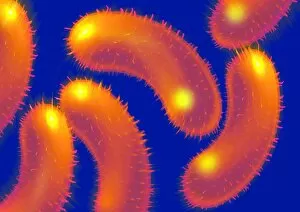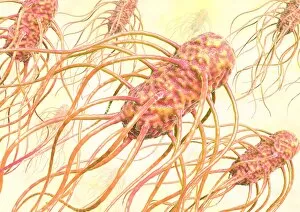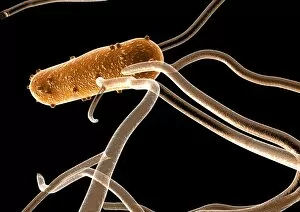Food Borne Collection
"Unseen Culprits: Exploring the World of Foodborne Bacteria" In a microscopic realm, where danger lurks unseen, lies the treacherous world of foodborne bacteria
All Professionally Made to Order for Quick Shipping
"Unseen Culprits: Exploring the World of Foodborne Bacteria" In a microscopic realm, where danger lurks unseen, lies the treacherous world of foodborne bacteria. Through powerful scanning electron microscopes (SEMs) and intricate artwork, scientists have unveiled the true faces of these notorious culprits. Meet Salmonella typhimurium bacteria, captured in stunning detail by SEM. With their rod-shaped bodies and flagella for mobility they can responsible for countless cases of food poisoning worldwide. Their presence on contaminated surfaces or in undercooked poultry can spell trouble for unsuspecting victims. Artwork C016 / 7538 showcases another glimpse into the life of Salmonella typhimurium bacterium. Its intricate structure is both fascinating and alarming as it reminds us that even something so small can wreak havoc on our health. But Salmonella doesn't stop there; artwork C013 / 8818 reveals more variations of this dangerous pathogen. Artwork C013 / 7809 exposes its ability to adapt and thrive in different environments while artwork C013 / 7808 highlights its resilience against harsh conditions. Delving deeper into the microbial world, we encounter Listeria bacteria through transmission electron microscopy (TEM). These tiny organisms possess a unique shape resembling rods or coccobacilli. In artwork C013 / 4727 and C013 / 4728, we witness their formidable presence within contaminated foods such as unpasteurized dairy products or deli meats. As we navigate this invisible battlefield between humans and pathogens, it becomes evident that knowledge is our greatest weapon against foodborne illnesses. Understanding how these bacteria operate empowers us to take necessary precautions when handling raw ingredients or consuming perishable goods. So next time you prepare a meal or enjoy your favorite dish at a restaurant, remember to stay vigilant against these hidden foes.











